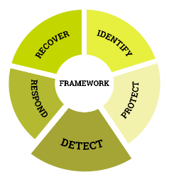Detect Cyber incidents
Within the Detect core function of the NIS2 directives, a number of measures and processes are established and managed. All with the purpose of detecting threats and vulnerabilities, so an organization can understand attack targets and methods.
On this page you will learn what is being expected from the NIS2 law and what kind of solutions Kappa Data can offer you.
Detect definition from Cyberfundamentals Framework
In the Cyberfudamentals framework of CCB Belgium a list of measures are described where you can find the headlines below :
- The organization shall ensure that a baseline of network operations and expected data flows for its critical systems is developed, documented and maintained to track events.
- Detected events are analysed to understand attack targets and methods
- Event data are collected and correlated from multiple sources and sensors
- Impact of events is determined
- Incident alert tresholds are established
- The network is monitored to detect potential cybersecurity events
- The physical environment is monitored to detect potential cybersecurity events
- Personnel activity is monitored to detect potential cybersecurity events
- Malicious code is detected
- Unauthorized mobile code is detected
- External service provider activity is monitored to detect potential cybersecurity events
- Monitoring for unauthorized personnel, connections, devices and software is performed
- Vulnerability scans are performed
- Detection activities comply with all applicable requirements
- Detection processes are tested
- Event detection information is communicated.
- Detection processes are continuously improved
Detect Cyber Incidents
In today’s digital age, cybersecurity is more important than ever. With increasing threats from cybercriminals, businesses must have robust detection systems to protect their data and operations. This article will explore the detection systems of Barracuda XDR and Sophos Managed Detection and Response (MDR), focusing on how they meet the Essential cover requirements of the Cyberfundamentals framework of CCB Belgium. We’ll dive into solutions like cloud security, DNS protection, IoT & OT security, network monitoring, and threat hunting in simple terms, featuring specific products such as Cloud Optix, DNS Protection in Sophos Firewall, IoT and OT Security with Sophos NDR interface, network monitoring with SolarWinds, and threat hunting platforms of Barracuda XDR and Sophos MDR.
Understanding Cyberfundamentals and CCB Belgium
Before we delve into the specific solutions, it’s essential to understand what the Cyberfundamentals framework is and why it matters. The Cyberfundamentals framework, established by CCB Belgium, outlines basic cybersecurity requirements that organizations should adhere to. These requirements ensure that businesses have a minimum level of protection against cyber threats, thus safeguarding sensitive information and maintaining operational integrity.
Barracuda XDR: A Deep Dive
Barracuda Extended Detection and Response (XDR) is a comprehensive security solution designed to detect, investigate, and respond to threats across an organization’s entire network.
Cloud Security: Cloud Optix
Cloud security is a critical aspect of modern cybersecurity strategies. Sophos Cloud Optix, a powerful cloud security tool that provides advanced threat detection and response capabilities. Cloud Optix continuously monitors cloud environments for suspicious behavior, ensuring that any potential threats are identified and mitigated quickly.
Key Features:
- Complete Multi-cloud security coverage: Across environments, Workloads and Identities
- Protect Cloud Workloads and data: Protect your infrastructure and data now and as it evolves with flexible host and container workload security.
- Enforce Least Privilege: Implement least privilege across your multi-cloud environments and manage your identities before they’re exploited.
- Secure Serverless environments: Build a layered defense against threats
- Network and applications security : integration of multiple cloud technologies into a single edge firewall to protect hybrid environments against threats.
DNS Protection on the Sophos Firewall
DNS (Domain Name System) protection is essential for preventing cyber attacks that exploit vulnerabilities in the DNS infrastructure. Sophos Firewall offers robust DNS Protection to safeguard users from phishing attacks, malware, and other DNS-based threats.
Key Features:
- Real-Time Threat Blocking: Blocks access to malicious websites and IP addresses.
- DNS Filtering: Filters DNS requests to prevent users from accessing harmful sites.
- Alerting and Reporting: Provides real-time alerts and detailed reports on DNS-related threats.
DNS Protection by Whalebone
Whalebone offers extra DNS protection as an extra security layer on top of a firewall in order to detect used techniques for cybersecurity incidents like :
- Domain Generating Algorithms (DGA’s) : Threat actors use DGAs so they can swiftly change the domains they’re using to launch malware attacks.
- Homograph Spoofing : Domains can be registered in multiple alphabets and character sets.
- Assets out of Network Attacks : Hybrid workers, workers in field, travelling workers, point their DNS traffic to their ISP or public wifi. Companies lose control over the security of the DNS traffic on these devices
- Compromised Credentials : Companies often don’t have credential policies inplace. Users reuse the same password across multiple sites. The dark web is full of sites offering login details and personal data.
- DNS Spoofing : refers to any type of malicious activity that alters DNS records returned to the user and thus point him/her to a malicious domain.
- IoT based attacks : Printers, cameras, servers, medical equipment, industrial machines — anything connected to the internet is both vulnerable and a vulnerability for the network.
- Malware : Adding a DNS layer to the security perimeter means that if malware falls through the standard security stack, there still a chance to stop it from spreading and causing damage.
- Phishing : To launch a phishing attack, the attackers need a domain — and if it pops up in any of Whalebone databases, if any user tries to access it for example through an e-mail which looks like it came from HR, they are stopped immediately.
- Supply Chain Attacks : The attackers find a vulnerability in a software which is widely used and use it to smuggle malicious payload into the network. Unfortunately, given that the trusted software is trusted by security measures, there is little anyone can do to prevent the drop. Nevertheless, it is possible to stop the consequence via severing the communication of the payload with the attacker.
IoT & OT Security: Sophos NDR Interface
The Internet of Things (IoT) and Operational Technology (OT) are increasingly becoming targets for cyber attacks. Sophos NDR (Network Detection and Response) interface offers specialized security measures to protect these critical components of modern business infrastructure.
Key Features:
- Device Discovery and Monitoring: Continuously monitors IoT and OT devices for unusual activity.
- Vulnerability Management: Identifies and addresses vulnerabilities in connected devices.
- Segmentation: Isolates IoT and OT networks from other parts of the business network to limit the spread of potential threats.
Network Monitoring: SolarWinds
SolarWinds Observability excels in providing real-time insights and advanced analytics to detect and mitigate potential cyber threats. By integrating seamlessly with your existing infrastructure, it enables proactive monitoring and swift identification of network anomalies, ensuring compliance with the CyberFundamentals Framework’s stringent requirements.
Key features include:
-
Real-time Network Monitoring: Continuous surveillance of network traffic helps in promptly identifying unusual activities and potential security breaches.
-
Advanced Analytics: Utilizes machine learning and AI to analyze patterns, predict potential threats, and recommend preventive measures.
-
Comprehensive Reporting: Generates detailed reports and dashboards that align with the CyberFundamentals Framework, aiding in compliance and management reporting.
-
Scalability and Flexibility: Designed to scale with your business, it supports a wide range of network devices and configurations, ensuring robust protection as your infrastructure grows.
Implementing SolarWinds Observability allows essential companies to significantly reduce the risk of cyber-attacks, ensuring a secure and resilient network environment. This proactive approach not only enhances your cybersecurity posture but also builds trust with stakeholders, demonstrating a commitment to maintaining robust security measures.
Threat Hunting: Barracuda XDR
Threat hunting involves proactively searching for cyber threats that may have bypassed traditional security measures. Both Barracuda XDR and Sophos MDR include robust threat hunting platforms to ensure that no threat goes undetected.
Barracuda XDR Key Features:
- Proactive Searches: Conducts regular threat hunting exercises to identify hidden threats.
- Advanced Analytics: Uses machine learning and AI to analyze data and uncover potential threats.
- Expert Security Team: Access to a team of security experts who specialize in threat hunting and incident response.
Threat Hunting: Sophos MDR
Sophos MDR includes proactive threat hunting to identify and neutralize hidden threats. This service ensures that your organization is protected from advanced cyber attacks.
Key Features:
- Expert Analysts: Access to a team of expert threat hunters.
- Advanced Detection Tools: Utilizes advanced tools and techniques to identify hidden threats.
- Continuous Improvement: Regularly updates threat hunting methodologies to stay ahead of emerging threats.

